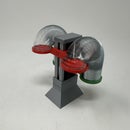Introduction: MicroWave
After publishing "Marblevator, Wave", a number of kinetic art wave mechanisms began showing up in my suggested video feed. All were beautiful yet quite large, so I decide to try my hand at making a micro kinetic art wave mechanism for 3D printing.
"MicroWave" is my attempt at a kinetic wave mechanism, in a very small form factor. The wave in this model consists of twenty four wave segments, each controlled by twenty four individual cams pressed onto a single camshaft. A gear motor rotates the camshaft, and as it rotates, each wave segment rises and falls in a sinusoidal motion. The mechanism is similar to the wave mechanism of YouTube publisher "rossmcsweeney" (https://www.youtube.com/channel/UC8BvunlXE6ECGMdCZz4Re5w) whose works are stunning.
Designed using Autodesk Fusion 360, sliced using Ultimaker Cura 14.12.1, and 3D printed in PLA on Ultimaker S5s.
Step 1: Parts.
I acquired the following parts:
- One N20 style 60RPM 6VDC gear motor.
- One four AAA cell battery holder with switch.
- Four AAA batteries.
I 3D printed the following parts at 20% infill:
- One "Axle.stl", .15mm layer height.
- One "Base, End.stl", .15mm layer height.
- One "Base, Motor.stl", .15mm layer height.
- Two "Base, Stretcher.stl", .15mm layer height.
- One "Bushing, Camshaft.stl", .15mm layer height.
- Twenty Four "Cam.stl", .1mm layer height.
- One "Camshaft.stl", .15mm layer height.
- One "Gear, Motor.stl", .15mm layer height.
- Twenty Four "Wave.stl", .1mm layer height.
This is a high precision print and assembly model. Prior to assembly, test fit and trim, file, sand, etc. all parts as necessary for smooth movement of moving surfaces, and tight fit for non moving surfaces. Depending on you printer, your printer settings and the colors you chose, more or less trimming, filing and/or sanding may be required. Carefully file all edges that contacted the build plate to make absolutely certain that all build plate "ooze" is removed and that all edges are smooth. I used small jewelers files and plenty of patience to perform this step.
Step 2: Base Assembly.
To assemble the base, I performed the following steps:
- Pressed "Axle.stl" into "Base, Motor.stl".
- Slid "Camshaft.stl" into the base assembly.
- Slid one "Wave.stl" onto the axle and camshaft.
- Pressed one "Cam.stl" on the camshaft.
- Made certain the camshaft rotated with ease.
- Repeated the previous three steps for the remaining wave and cam components. Note that as each cam is installed on the camshaft, it is rotated 30 degrees from the previous. (The cams and camshaft have twelve sided polygons to help with alignment.).
- Pressed "Bushing, Camshaft.stl" onto the end of the camshaft.
- Pressed two "Base, Stretcher.stl" into the base assembly.
- Pressed "Base, End.stl" onto the base assembly, aligning the camshaft bushing, axle and two stretches with the holes and pockets in the base end.
Step 3: Final Assembly.
To complete the model, I performed the following steps:
- Soldered the battery case wires to the motor (polarity is not important as the model will function rotating in either direction).
- Pressed the motor into the base assembly.
- Pressed "Gear, Motor.stl" onto the motor shaft.
- Placed four AAA batteries in the battery case.
With final assembly complete, I slid the battery case power switch to on and took a Dramamine (ok, not really)!
And that is how I 3D printed and assembled "MicroWave".
I hope you enjoyed it!






















